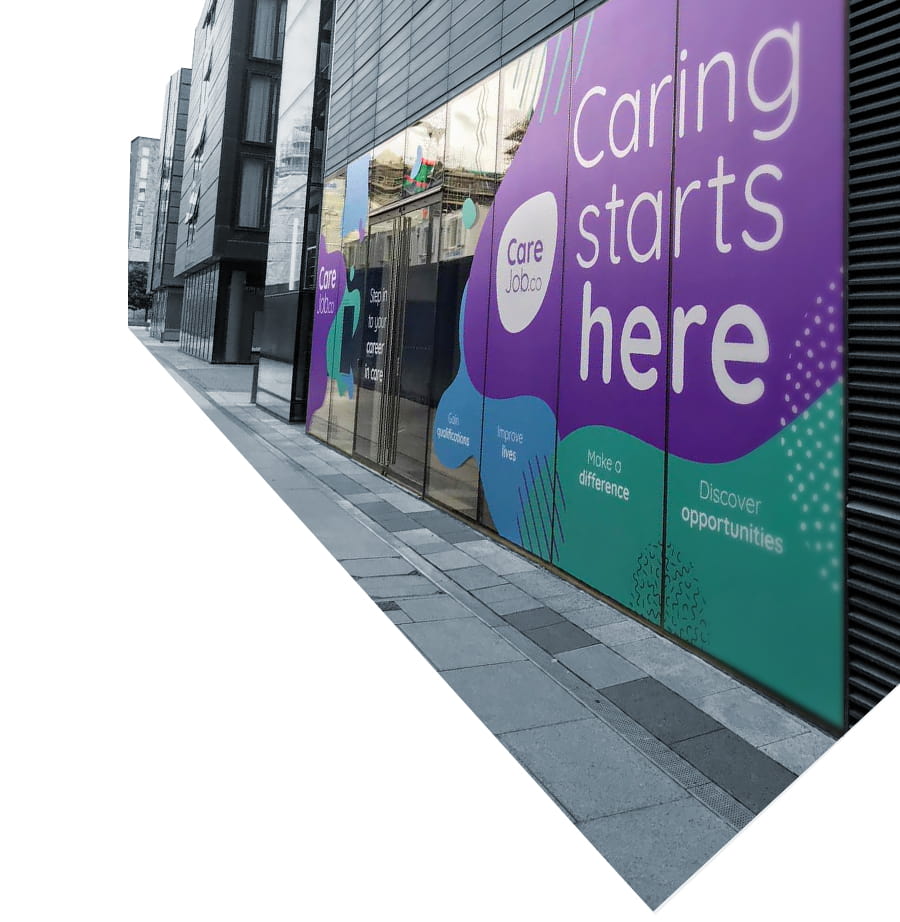Problem Statement
Care providers in Edinburgh reported vacancies remaining unfilled for weeks due to fragmented hiring processes and complex paperwork. Meanwhile, job seekers found applications repetitive and time-consuming. A streamlined, highly customisable, user-friendly solution was needed to reduce friction while ensuring compliance.
Specifically, the Novacare platform (see project) would serve as the backbone to an Edinburgh-specific initiative, with the potential to expand to further Local Authorities if successful. And all of this within a very tight deadline.
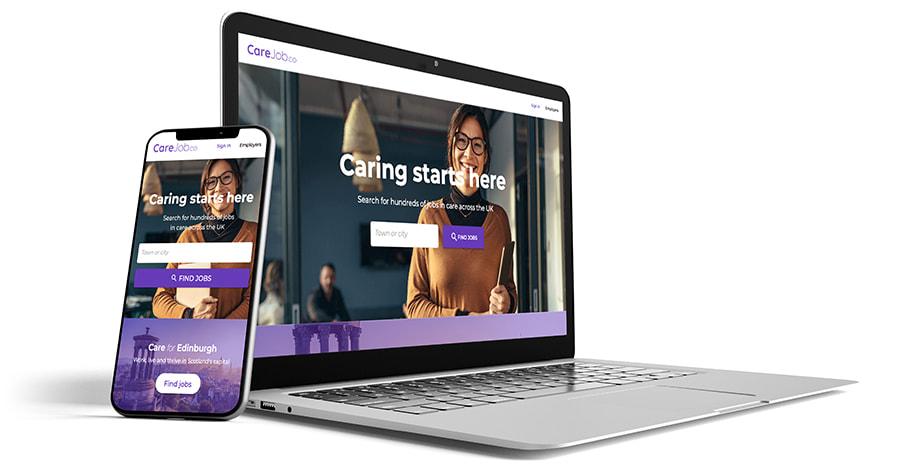
Solution Implemented
We developed CareJob, a Progressive Web App (PWA) integrating with Novacare’s backend, allowing flexible data integration and customisable recruitment processes for care providers. The goal was to simplify job discovery and applications under a tight deadline while ensuring compliance and a seamless mobile-first experience.
- Technology and Tools used: Angular/Material, Adobe XD, Flowmapp, OptimalWorkshop, Jira/Confluence, Zeroheight
- Collaborators and Stakeholders: Business Owner & Sales, Care Providers & Staff, Local Authorities, Developers
Process & Experience
Balancing the needs of clear and established user cohorts with regulatory requirements, we focused on simplifying the application process while allowing a high degree of customisation and maintaining all required data points from various recruitment tracks.

Job seekers within the UK care sector (and initially specifically Edinburgh & Lothians) – Recruited multiple participants for regular interviews, surveys and prototype/live testing sessions.
Care recruiters – Liaised closely with HR administrators from three care providers.
Local Authorities & regulatory bodies – Updated and gathered feedback through regular meetings.
“I don’t mind giving details later, but at the start, all I want is to get the application in fast!” — Care worker in application process, survey
“I just want to apply quickly, but it feels like I’m filling in paperwork for an hour.” — Newly hired care assistant, user interview
“Currently, there is no way for me to just post a job easily and have it integrate into our existing systems.” — HR Administrator, user interview
Through interviews and gathered feedback and analytics from Novacare, we uncovered initial critical insights:
- Clarity and speed matter – Job seekers prioritised fast applications over excessive detail upfront
- Flexibility and customisability for care providers – HR teams needed adaptable tools that fit into existing workflows
- Also, mobile-first is non-negotiable – The majority of job seekers complete the process on their phones
A competitive analysis of mobile-friendly job platforms, specifically benchmarking against Indeed, helped shape a more intuitive user experience.

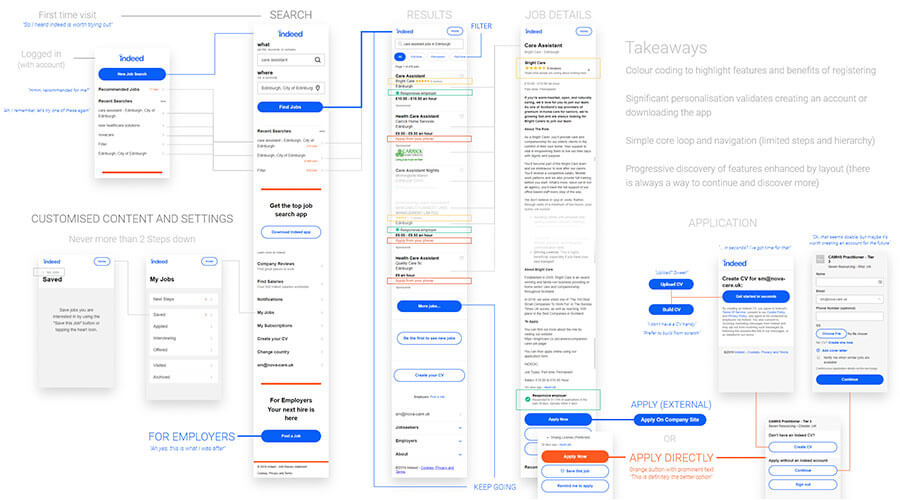
Structure & Technology
Rather than personas, actual recruited users’ testimonials, feedback and screen recordings were used to establish key user stories to work towards and distil the relevant tasks, and subtasks, prioritising essential features for the Minimum Viable Product (MVP):
- Streamlined recruitment/application flows – Simplified complexity while ensuring compliance, improving usability for both job seekers and care providers.
- Flexible integration and support – Ranging from a free vacancy/advert builder with customisable requirements to full Novacare suite integration, for example for HR processes post-employment.
- Use of Angular, leveraging Novacare database & API – Needed to integrate seamlessly while maintaining a standalone, mobile-first experience optimised for Google and other data requirements.
- Scalability – The initial requirement for notifications and messaging suggested a native app, but PWA was chosen for faster delivery, flexibility, state management and working with low connectivity.
- Maximise reach of vacancies to be found (regardless of platforms, vacancy requirements and level of detail submitted by applicants)
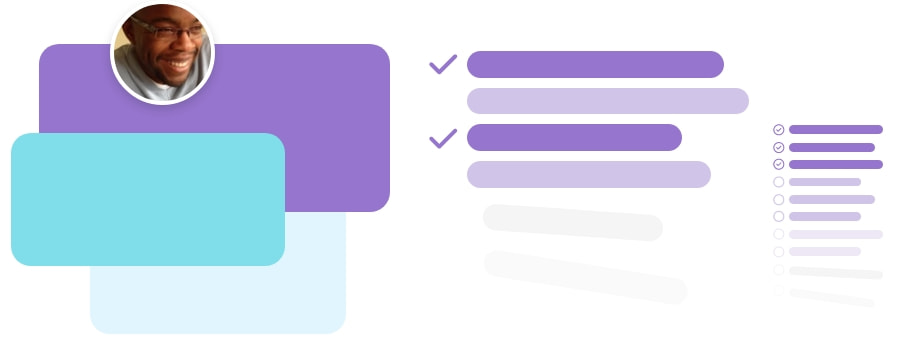
We also defined further global principles, specifically relating to handling of user data:
- Collecting the absolute minimum of data until required, and comply with data security.
- Always allow to view all submitted data, allow undoing of any action, and editing until the latest point possible. Keep history of versions, until deletion of all data in compliance with GDPR.
- Routes through the process without account creation are available.
- Only show what is relevant to the user at the specific point in the journey, use progressive and postpone until required
- Clearly communicate status and provide guidance: What’s happened, what’s next, nudge towards agreed desired and recommended levels of detail
- Automate tasks when possible, e.g. auto-saving, pre-populating data, using relevant placeholders – but be wary of unintentional implications
- Design with real data and max cases, but mask sensitive information in all mockups
- Defining a shared glossary to align vocabulary for all stakeholders, e.g. what exactly does “delete” or “save” mean in the context of this project
Establishing initial structure of the full recruitment process (max. case):

And then progressively expanding with logic and states to scope out the MVP:
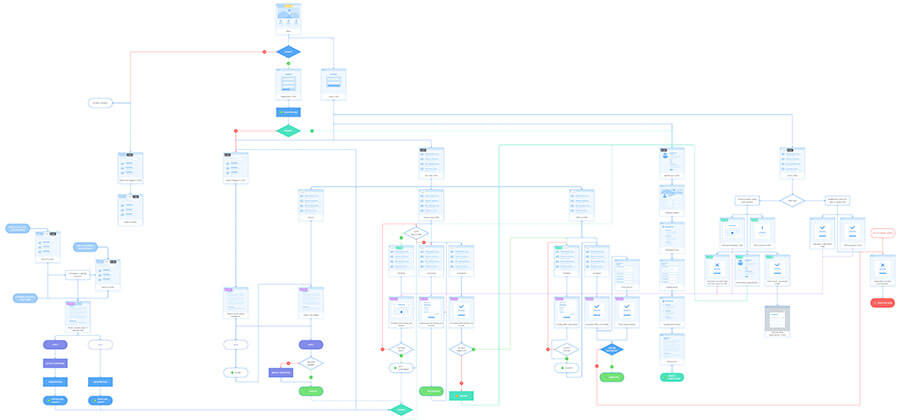
Defining structure of vacancy across the builder, cards, open graph excerpts and detail views:
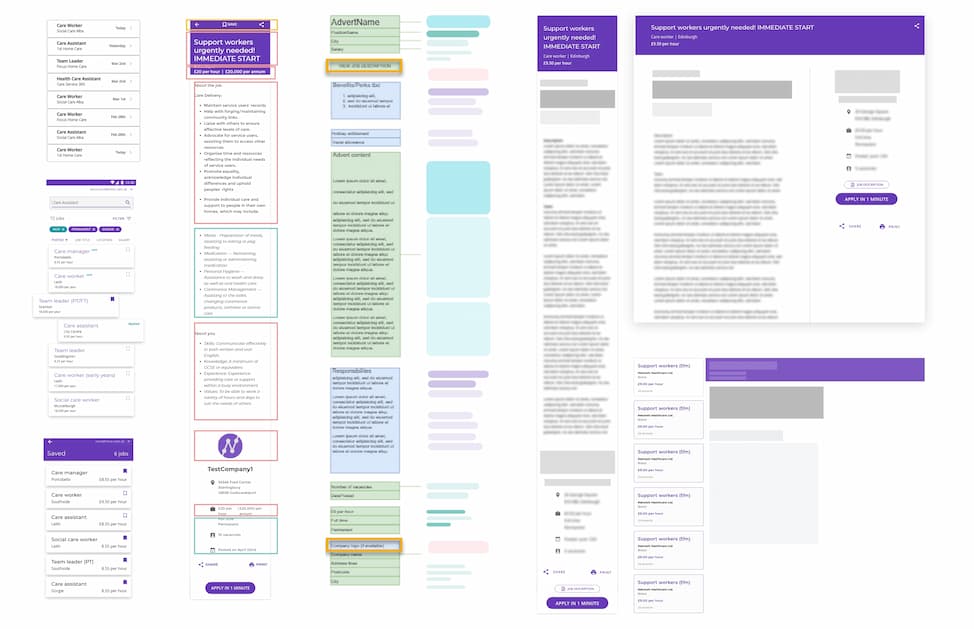
Ensuring Data Compatibility
A major challenge was standardising various ways of asking the same question while ensuring compatibility with existing database structures. This required a rigid question protocol and structured consolidation to align all inputs for seamless data handling.
To improve distribution and reusability, job data was structured to align with Schema.org and Google’s JobPosting Schema Markup.
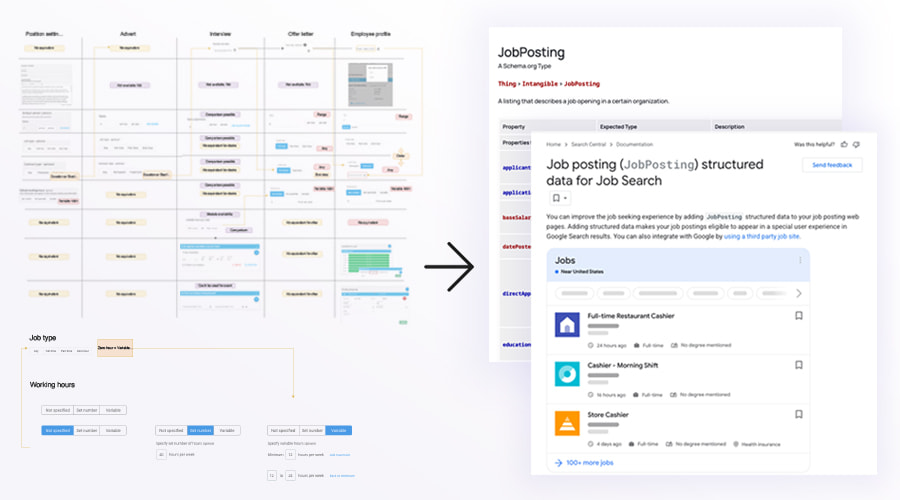
Design System & Theming
A modular, flexible design system was built using Angular/Material theming and documented with Zeroheight – with minimal customisation: We noticed in testing that Material floating labels and datepickers caused confusion for mobile users, so we replaced these patterns. Initial mockup tests pushed for removal of redundant items to reduce cognitive load and focus on accessibility.
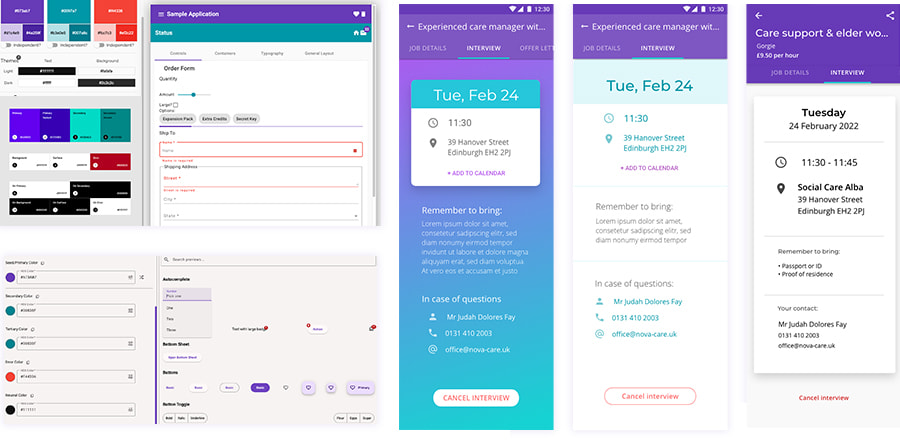
Outcome: MVP launched successfully and on time
Launched within deadline with a focus on delivering a simplified, mobile-first experience, ensuring core features such as advert creation, job search, application submission, interview scheduling and integration with Novacare’s backend were fully functional. With key routes for notifications, messaging, and future integration left open, pending further vindication.
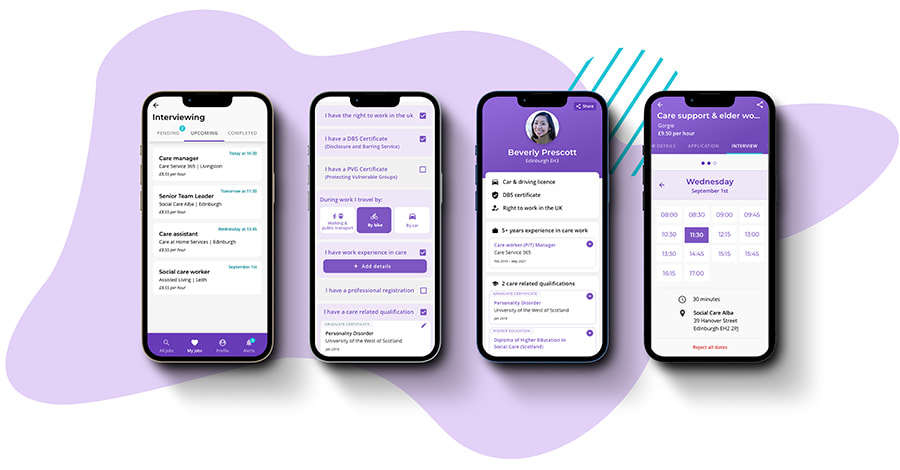
Key Results
- Immediate take-up by care providers across the UK, leading to over 3,000 live job opportunities in two months—compared to previous processes that took weeks to post and fill vacancies.
- Up to 90% reduction in application time for job seekers.
- Improved data consistency, ensuring better compatibility for care providers.
- Faster deployment through the PWA model, reducing development overhead.
- Positive early feedback from care providers on ease of use and integration.
Key Takeaways
- Simplifying regulatory-heavy processes is crucial for user adoption.
- PWA proved to be a more scalable solution for industry-wide adoption.
- Data structuring from the start ensures better integration and long-term usability.
- Tight deadlines demand lightweight, adaptable design systems.
What happened next
With user feedback gathered and based on high uptake, the next MVP focused on:
- Adding functionality specifically for requirements in England and Wales
- Sorting & filtering (especially by location) identified as a key user pain point.
- Enhanced reporting functionality, and allowing care providers to search for applicants using the same structured data principles.

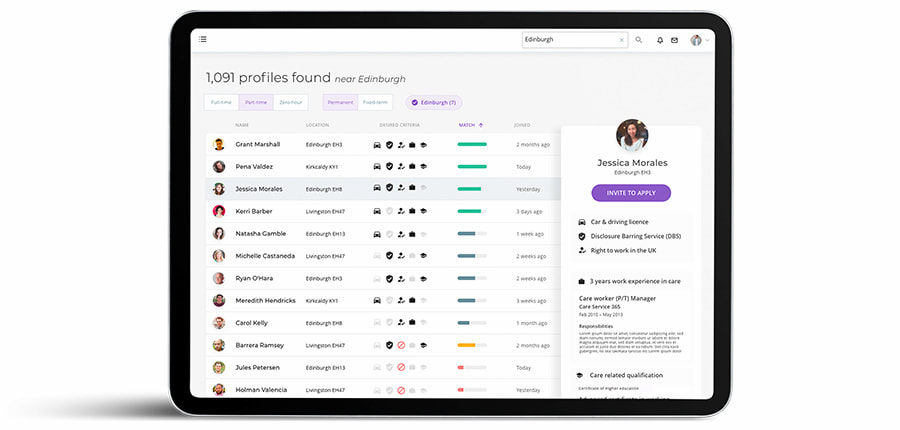
We also produced marketing collaterals, tutorial videos, guidance materials and acted on requests for physical presence and documentation with use of data for reports and opening offices for in-person support.

